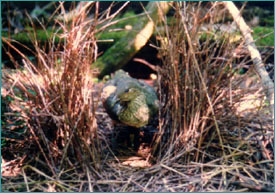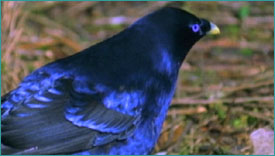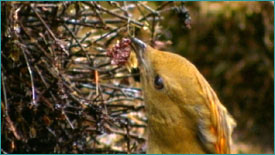 |
 |
|
|  Energized by remote control, a robotic female satin
bowerbird awaits a gullible male.
Energized by remote control, a robotic female satin
bowerbird awaits a gullible male.
|
On the Trail of the Bowerbird
Part 2 | Back to Part 1
NOVA: I've heard that you have used robotic female bowerbirds. Why?
Borgia: One of my students, Gail Patricelli, has just gotten a paper accepted
at Nature that describes how she has used a robotic female bowerbird to
study courtship. She was interested in studying communication between males and
females.
We considered building robotic males and females for the reason that if you can
build a robot and control its behavior then you can offer a kind of controlled
stimulus to a member of the opposite sex. The problem with building males is
that their behavior and courtship movements are so complicated that it would be
very difficult to build a robot that could accurately mimic a male. But with
females their movements are much more limited, and they do not move around so
much, so we could build a robot that mimics female movement quite well.
We used that to study how males court females and how males respond to female
signals. What we found is that males observe the rate at which females crouch
within the bower. If the female is crouching relatively rapidly the male feels
comfortable displaying with a very high intensity. But if she is kind of
reluctant to go down into a copulatory position then he will modulate his
display so that it is less intense. So Gail, with her robots, was able to show
a relationship between female movement downwards and male intensity of
display.
 Fired with lust, male satin bowerbirds have
tried to mate with Patricelli's robots.
Fired with lust, male satin bowerbirds have
tried to mate with Patricelli's robots.
|
|
NOVA: I read that the female robots were so lifelike that the males even tried
to copulate with them.
Borgia: Yes. A BBC crew just went out with them and in that sequence the males
copulated with the female robots.
NOVA: Or tried anyway.
Borgia: Yeah.
NOVA: I've read that satin bowerbirds may use a leaf or a twig to paint the
inner walls of their bowers with a stain? Would that be considered tool
use?
Borgia: Well, I've read that too but I've never seen it. What I see, at our
study site in particular, is the satin bowerbirds chewing on hoop pine and then
rubbing that chewed hoop pine onto the sticks of the bower. When the females
come in they taste it. So there is definitely painting going on, but I have
never seen them use a tool. I would argue, however, that there are other
examples of tool use in bowerbirds. The use of decorations and the use of the
bower itself seem to be tools to me.
NOVA: Is tool use something you see in other birds?
Borgia: If you define a nest as a tool then tool use is pretty widespread among
birds. It all depends on how you define a tool.
NOVA: Among bowerbirds, which do you believe came first: courtship dancing,
decorating, or bower building?
Borgia: That's a good question. Courtship dancing is fairly ubiquitous—it's
done by all the species—so I would have to guess that that kind of thing has
been there all along, though probably not as elaborate as it is in
bowerbirds.
|  This tooth-billed bowerbird's display
is a selection of fresh green leaves carefully arrayed on the forest floor.
This tooth-billed bowerbird's display
is a selection of fresh green leaves carefully arrayed on the forest floor.
|
It's a toss-up, though, as to whether bowers or decorations came first. When
one builds a phylogeny or evolutionary history of bowerbirds and asks where in
that sequence do bower building and decoration appear, as soon as you leave the
monogamous bowerbirds, called the catbirds, all the rest of the bowerbird
species build and decorate bowers, with a few exceptions. And both those traits—decorating and bower building—seem to come on together. So there's no
really hard evidence that one comes before the other.
My guess is that the decorating might have come first. One argument for that is
that birds of paradise do limited decoration, as do a few other species as
well. So that seems to be a more widespread trait that could easily have
evolved first, and then bowers might have come along as a way of focusing the
attention of the female on the display side. But I could be completely wrong.
One could come up with reasonable scenarios that would put bower building
first, too.
NOVA: You've written that the bower of the Macgregor's bowerbird, which
decorates a sapling with sticks and moss, may be most similar to the ancestral
one for all bowerbirds. How did you come to that conclusion?
Borgia: Well, if one thinks about the nature of bowers generally, you have two
main types. You have a single maypole typified by the Macgregor's and then an
elaboration of that in related species that build huts around that maypole.
Among those, the single maypole seems to be the simplest design. The other
major grouping of bowerbirds build a two-walled structure, and the question is,
how do you get to a two-walled structure from nothing? My guess is that you
could go easily from a maypole-decorating habit to a single wall without a
maypole and then to a two-walled structure. That's how I envision things
happening.
 A male Macgregor's bowerbird decorates
his maypole-style bower.
A male Macgregor's bowerbird decorates
his maypole-style bower.
|
|
Again, there is no hard evidence that it actually happened that way. And the
reason why we don't have hard evidence is because if one looks at the phylogeny
of the bowerbirds and who builds what at the ends of the phylogeny, what
you find is that within each of the major groups, the maypole builders and the
avenue builders, there is not a lot of predictability based on the
relationships within those groups. It appears that throughout the evolution of
bowerbirds they have changed very quickly the kinds of bowers they can build,
and so that makes it very hard to use the phylogeny to go backwards and predict
what ancestors' bowers were like. Actually, just having worked on spotted
bowerbirds that have very variable bowers within a population again suggests
that there is a high degree of mobility in bower building, even within a
population.
NOVA: How did you come to study bowerbirds?
Borgia: Well, I had done a Ph.D. on dung flies. Now, they are thoroughly
interesting and wonderful animals, but I thought insects were a little more
limited in their behavior. I'm very interested in finding systems in which I
can study the behavior of animals and look at the possibility that these
animals are optimizing their behavior. So I wanted to look at sexual selection
in animals with larger brains that can figure things out more than most
insects can. I wanted to look at a vertebrate, particularly a bird. Bowerbirds
and their very elaborate sexual displays struck me as perhaps the most exciting
animals and animal behavior to study, so I decided to go to Australia and study
them.
Continue: New bowerbird species left to discover?
Photo credits
On the Trail of the Bowerbird |
Are Bowers Art? |
Creature Courtship
Bowerbird Matching Game |
Resources |
Teacher's Guide
Transcript |
Site Map |
Flying Casanovas Home
Search |
Site Map |
Previously Featured |
Schedule |
Feedback |
Teachers |
Shop
Join Us/E-Mail |
About NOVA |
Editor's Picks |
Watch NOVAs online |
To print
PBS Online |
NOVA Online |
WGBH
© | Updated December 2001
|
|
|
|